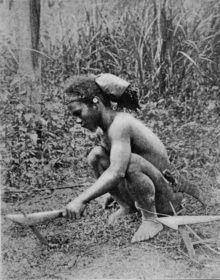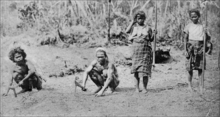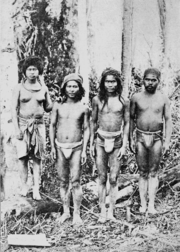Ilongot
 An Ilongot man at work in clearing (c. 1910). | |
| Total population | |
|---|---|
| 87,000 | |
| Regions with significant populations | |
|
(Nueva Vizcaya, Nueva Ecija, Quirino, Aurora, Northern Luzon) | |
| Languages | |
| Ilongot, Ilocano, Filipino, English | |
| Religion | |
| Animism, Paganism, minority Christianity | |
| Related ethnic groups | |
| Igorots, Ibanag, Ilocano, other Filipino ethnic groups, Austronesian peoples |

The Ilongot (or Ibilao[1]) are a tribe who inhabit the southern Sierra Madre and Caraballo Mountains, on the east side of Luzon in the Philippines, primarily in the provinces of Nueva Vizcaya and Nueva Ecija and along the mountain border between the provinces of Quirino and Aurora. An alternative name of this tribe and its language is "Bugkalot". They are known as a tribe of headhunters.
Presently, there are about 87,000 Ilongots.[2] The Ilongots tend to inhabit areas close to rivers, as they provide a food source and a means for transportation. Their native language is the Ilongot language, currently spoken by about 50,000 people. They also speak the Ilocano language.
Culture


In Ivan Salva’s study in 1980 of the Ilongots, she described “gender differences related to the positive cultural value placed on adventure, travel, and knowledge of the external world.” Ilongot men, more often than women, visited distant places. They acquired knowledge of the outside world, amassed experiences there, and returned in order to share their knowledge, adventures, and feelings in a public oratory in order to pass on their knowledge to others. The Ilongot men received acclaim as a result of their experiences. Because they lacked external experience on which to base knowledge and expression, Ilongot women had inferior prestige.
On the basis of Michelle Rosaldo’s study and findings of other stateless societies, anthropologists must distinguish between prestige systems and actual power within a society. Just because a male has a high level of prestige, he may not own much economic or political power compared to others that are less prestigious within the society.
Renato Rosaldo went on to study headhunting among the Ilongots in his book Ilongot Headhunting, 1883-1974: A Study in Society and History. He notes headhunting raids are often associated with bereavement, a rage and expiation at the loss of a loved one.
Because of the early experiences of boys living in a close relationship with both parents, who each participate in "motherly" roles, they are relatively unconcerned about the need for achievement or even defaming women. Men involved in household chores do not claim submission to their wives. In social life, the Ilongots show little stratification and sexual inequality but it is certainly present. It is minimized by the fact that women have the right, as well as feel confident enough, to speak their minds. Finally, we find the home gender relations based on equality, focusing on cooperation instead of competition and there is a real intimacy between husband and wife. Rosaldo's conclusion is that perhaps the most egalitarian societies are those where no sex order authority exists, and where the focus of social life itself is the home.
Mythology
According to the Ilongot people, the creators of the universe are two quarrelling brothers. There original names have been lost due to the introduction of Roman Catholicism by the Spanish in the 16th to 19th centuries. Some people nowadays refer to them as Cain and Abel, which were taken from the bible, but are not their true names. Abel was a shepherd who is known to have been looked upon favourably due to his propensity to self-sacrifice. While Cain who worked in agriculture was known for his inclination towards chaos.
The Ilongot people identify those who live down in the lowlands as following the spirit of Abel. They view them as superior as well as having had learned to work with the domesticated animals such as Carabao. The Ilongot see themselves as following in the footsteps of Cain and his spirit of chaos. However, many sources conflict with this as the story may have been crafted decades ago by a Spanish implying that the lowlanders are 'more civilized' because they are 'Christians', which demeans the Ilongots and their own culture. Due to this, many Ilongots reject the side story of Cain and Abel.
Deities without Catholic renditions known to the Ilongots are:
- Taon - The god of the sky.
- Pandac - The god of the stars
- Delan - The moon, usually he and Elag are congenial and take turns giving light; but sometimes they quarrel and Elag covers Delan more or less with a great, huge winnowing bila-o (basket). Thus we have the different phases of the moon. He and Elag created mankind. The Christian-inspired Cain and Abel story conflicts with this as it states that it was Cain and Abel who created men instead.
- Elag - The sun, they worship him (it) so as the moon and stars because they give life and growth. He has a great, magnificent house in Gacay. When he gets tired giving light and goes into his house, it is night. He and Delan created mankind. The Christian-inspired Cain and Abel story conflicts with this as it states that it was Cain and Abel who created men instead.
- Gemang - The guardian of wild beasts. When a party of men is starting on a hunt, they build a fire, take hold of the dogs and the weapons and pass them one by one through the smoke. The last dog to be passed through the smoke is the leader of the pack. After taking it out of the smoke, the owner spits on its face, and rubs the saliva down its back and sides. Meanwhile, he has been talking and shouting to Gemang, saying: "Do not let our dogs get sick. You must give us one of your animals. Do not take the form of a wild beast so that the dogs chase you by mistake. If you will let the dogs catch one beast, then we will give you to eat and drink and likewise your wife." Following this ceremony, the part starts out in a successful hunt.
- Keat - The god of lightning.
- Kidy - The god of thunder
- Lampong - The dwarf shepherd of the wild animals.
- Oden – The rain, they worship him (it) for its life-giving water.[3]
Gallery of Ilongot art
- A headdress made of horn bill, shell, wire, rattan and hair
- A bracelet made of brass, beads and mother of pearl
- A necklace made of brass, mother-of-pearl and beads
- Men's ear pendants made of hornbill, discs of shell, beads and brass
- Earrings made of shell, brass and beads
- A hair ornament
- A pendant made of Japanese coins, brass, aluminum and glass
- Men's ear pendants (batling) made of hornbill, brass, shell and cotton
References
- ↑ Barrows, David P. (December 1910). "The Ilongot or Ibilao of Luzon". Popular Science Monthly.
- ↑ https://joshuaproject.net/people_groups/12214/RP
- ↑ https://www.phillife.co/ilongot-tribe-headhunters/
- Phillip, Conrad. (2005). Window on Humanity. New York: McGraw-Hill
- Rosaldo, Michelle Zimbalist, Lamphere Louise. A Mulher. A Cultura e a Sociedade. (“Woman. The Culture and Society”) Brazil: RJ. Paz e Terra, 1979. Coleção O Mundo hoje. (“The world today”) 31. p. 58.
- Rosaldo, Renato. from Culture and Truth: The Remaking of Social Analysis. "Introduction: Grief and a Headhunter's Rage" (pp. 1-21).
External links
| Wikimedia Commons has media related to Ilongot. |